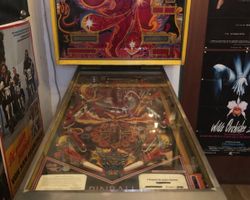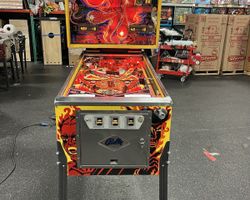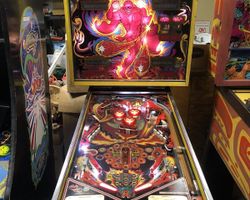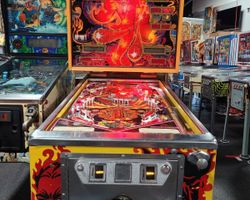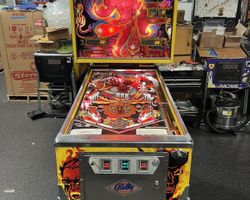Fireball II

Average Prices: USD $400 to $1,800
Produced: June, 1981
Production Run: 2,300 units
Machine Type: Solid State Electronic
MPU: Bally MPU AS-2518-35
Players: 4
Design by: Gary Gayton
Art by: Dave Christensen
Bally Manufacturing Corporation introduced Fireball II in June 1981, building upon the rich legacy of its predecessor. This solid-state electronic pinball machine, designed by Gary Gayton with artwork by Dave Christensen and software by Rehman Merchant, emerged during a pivotal era for Bally, a company synonymous with innovative pinball design. The machine drew inspiration from a fantasy theme, utilizing the imagery of fire and a mischievous imp to create a distinct visual and auditory experience. With a production run of 2,300 units, Fireball II sought to captivate players with its blend of classic pinball elements and novel features, aiming to stand out in a competitive market. A particular influence on Fireball II came from an unexpected source: the 1971 Williams machine Doodle Bug, designed by Norm Clark. As head of design at Bally during Fireball II's development, Clark advocated for the inclusion of a similar animated captive ball bonus feature, a mechanical innovation that became a signature element of Fireball II.
Signature Features and Design
Fireball II distinguishes itself with several unique elements that enhance both its visual appeal and gameplay. Central to its identity is the artwork by Dave Christensen, which bathes the playfield, backglass, and cabinet in a vibrant palette dominated by reds and yellows, effectively conveying the "fire" theme. The main antagonist, a horned imp, is prominently featured, setting a fantastical tone.
Among the standout mechanical features, the "Little Demon" post is a significant innovation. Positioned strategically between the two main flippers, this rubbered post is activated by an extra button located below the right flipper button. When pressed, the post extends upward, providing players with a crucial, player-controlled save mechanism. This feature transforms potential drains into opportunities for continued play or even setup shots, adding a layer of direct player interaction rarely found in this era.
Another defining characteristic is the sub-playfield captive ball mechanism, a direct result of Norm Clark's influence. Unlike typical playfield features, this captive ball is located beneath the main playfield and rolls repeatedly across a point-scoring rollover button, activated during a bonus scoring animation at the end of each ball. This creates a visually engaging and unique method for players to accumulate bonus points, setting Fireball II apart from its contemporaries. The machine also features custom speech, an advanced capability for its time, with a sinister voice complementing the devilish theme and adding to the game's immersive atmosphere. These elements collectively contribute to a cohesive design that is both visually striking and mechanically engaging.
Playfield and Mechanics
The Fireball II playfield is meticulously designed for varied shot opportunities and an engaging flow. It features a traditional three-flipper layout, with two standard flippers at the bottom and an additional, smaller flipper positioned in the upper-right section of the playfield. This upper flipper is crucial for accessing shots to the upper playfield targets and a kick-out hole.
The primary targets for players are the extensive array of drop targets. The playfield includes two banks of four drop targets each, often arranged in a staggered fashion, demanding precise aim. Additionally, there is a single bank of three drop targets. Successfully clearing these banks not only awards points but also often lights features or progresses toward multiball. Complementing these targets are three pop bumpers, centrally located, which provide chaotic, high-scoring action as the ball ricochets within their cluster. Two kick-out holes are strategically placed; one at the top of the playfield often acts as a target for the upper flipper, while the other might serve as a reward for hitting a specific sequence of targets.
The playfield's overall flow is designed to keep the ball in motion, rewarding players who can maintain control and execute accurate shots. The abundance of drop targets encourages a strategic approach, where players must decide whether to go for individual targets or attempt to clear entire banks. Dave Christensen's artwork on the playfield is vibrant and intricate, featuring flames, demonic figures, and stylized fonts that reinforce the machine's theme. The general illumination and strategic use of flashers, particularly during multiball, enhance the visual spectacle, drawing players deeper into the fiery world of Fireball II. The layout, while challenging, allows for a satisfying rhythm once mastered, contributing to the machine's lasting appeal.
Gameplay Dynamics
Fireball II's gameplay dynamics center around its multi-ball feature and the strategic use of its diverse targets. The primary objective often revolves around initiating multiball, which is typically a three-ball experience, though sometimes described as two or three balls depending on setup. Achieving multiball usually involves lighting and locking balls by hitting specific targets or sequences, leading to frantic, high-scoring opportunities as multiple balls are in play. The game's custom speech and flashing lights contribute to the excitement during these multiball phases.
The scoring system rewards precision and target completion. Clearing drop target banks is paramount, as these contribute significantly to scoring and can advance game objectives. The three pop bumpers also offer quick points, particularly when the ball is trapped within their area. One of the unique aspects of Fireball II is its multiplayer dynamic, where successfully locking a ball for multiball can potentially "steal" a locked ball from an opponent, adding a competitive edge to head-to-head play.
The "Little Demon" post plays a crucial role in gameplay strategies. Players learn to anticipate drains and activate the post to save the ball, or even to redirect it into a more favorable position for a subsequent shot. The under-playfield captive ball, while passive during active play, contributes to the overall bonus score at the end of each ball, adding anticipation as players watch their accumulated bonus tally. The game's objectives, while seemingly straightforward—hit targets, achieve multiball—require a blend of control, timing, and quick reflexes. Success often hinges on mastering the pathways to multiball and effectively utilizing the "Little Demon" post to prolong ball times and maximize scoring.
Reception and Legacy
Fireball II has cultivated a reputation as an enjoyable and often underestimated early solid-state pinball machine. Among pinball enthusiasts, it is frequently praised for its engaging gameplay and visually striking presentation. The artwork by Dave Christensen consistently receives commendation, with its vivid red and yellow palette effectively capturing the machine's theme. Many players find the gameplay to be fast-paced, challenging, and addictive, prompting repeated plays to master its nuances.
The "Little Demon" post is a recurring highlight in player feedback, recognized for its unique strategic depth and ability to influence ball control. Multiball sequences, particularly with three balls in play, are cited as exhilarating and visually impressive. For multiplayer sessions, the ability to steal locked balls from opponents introduces a competitive dynamic that enhances the experience. The array of drop targets and various shots, including an upper saucer shot, are valued for requiring precision and rewarding skillful play. The machine's overall flow is generally well-regarded, contributing to a fluid and continuous game. Furthermore, for collectors of early solid-state Bally titles, Fireball II often represents an accessible entry point offering significant quality for its era. The integration of its "devil" theme with sinister speech and light effects is also frequently noted as a strong point.
However, Fireball II is not without its points of contention. Some players find the inlane/outlane configurations to be less forgiving or, conversely, too easy, occasionally leading to quick drains or unusually long ball times if the rules allow for extended multiball sessions. The geometry of the pop bumper area has been mentioned as presenting unusual bounces by some. While generally addictive, a few players have found the game can become somewhat repetitive during extended play sessions, particularly if the rule set is not optimally tuned. Despite being a distinct design, Fireball II sometimes faces comparison to its electromechanical predecessor, the original Fireball, which featured different mechanics like zipper flippers, leading to an unfair "sequel stigma" in some opinions. Technical maintenance of specific sub-playfield mechanisms has also been cited as a challenge by some operators. Nevertheless, Fireball II's strong visual identity, player-controlled save feature, and challenging multiball action secure its place as a notable entry in Bally's solid-state era, demonstrating how engaging design and a unique feature set could create a compelling pinball experience in the early 1980s.
Sponsored Links
 Ebay Listings
Ebay Listings
 Auction Results
Auction Results
| Cost | Location | Date |
|---|---|---|
| USD $2,200 |  Ohio, United States Ohio, United States |
10 November, 2025 |
| USD $4,889 |  Florida, United States Florida, United States |
03 December, 2024 |
| USD $2,500 |  Pennsylvania, United States Pennsylvania, United States |
06 August, 2024 |
| EUR €835 |  Bayern, Germany Bayern, Germany |
12 July, 2024 |
| USD $3,488 |  Florida, United States Florida, United States |
31 March, 2024 |
| USD $3,888 |  Florida, United States Florida, United States |
24 March, 2024 |
| EUR €250 |  Saarland, Germany Saarland, Germany |
15 December, 2023 |
| USD $3,500 |  Georgia, United States Georgia, United States |
08 September, 2023 |
| USD $4,889 |  Florida, United States Florida, United States |
11 June, 2023 |
| USD $3,889 |  Florida, United States Florida, United States |
16 April, 2022 |


Private Policy · Search Website · Contact Us
As an eBay Partner, we may earn a commission from qualifying purchases made through links on this site, at no additional cost to you.
All trademarks and copyrighted materials remain property of their respective owners. All other content copyright 2007 - 2025 Pinpedia.

